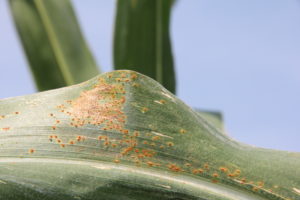This article is modified from Darcy Telenko’s article about field corn in a recent Purdue Pest and Crop newsletter.
Southern rust of corn is normally a disease of tropical areas. During summer months, however, the fungus which causes southern rust, Puccinia polysora, may move into Indiana or other Midwestern states. Southern rust has officially been confirmed in Posey and Vigo County. If you think you have this disease contact me or submit a sample to the PPDL https://ag.purdue.edu/btny/ppdl/Pages/Submit-A-Sample.aspx
Southern rust pustules generally tend to occur on the upper surface of the leaf, and produce chlorotic symptoms on the underside of the leaf (Figure 1). These pustules rupture the leaf surface and are orange to tan in color. They are circular to oval in shape. We are seeing a lot of common rust as well and both diseases could be present on a leaf.

Figure 1. Southern rust pustules on corn leaf. Pustules generally form and erupt on upper surface. (Photo by A. Sisson, Iowa State University).
Common rust will form pustules on both sides of the leaf. In addition, common rust pustules tend to be spread out across the leaf, and less densely clustered. Common rust pustules have a brick red to brown coloration and may be more elongated than southern rust pustules.
Check out the southern rust publication for more images of southern rust and other diseases that might mimic it. This publication also has good information on determining when a fungicide application will be beneficial. The publication is at following link: https://crop-protection-network.s3.amazonaws.com/publications/cpn-2009-southern-rust.pdf.
The fungus that causes southern rust requires a living host plant to survive. Thus, the fungus does not overwinter in Indiana and instead must be blown into the state. When conditions favor rust development, the disease may become severe in a short period. A new rust pustule can develop from an infection in just 9 days and each rust pustule can produce rust spores for about 8 days.
Infection by the southern rust fungus can take place after about 6 hours of leaf wetness. Therefore, dew can often provide sufficient leaf wetness. Southern rust is favored by high relative humidity and temperatures around 80°F.
Young leaves are more susceptible than mature leaves, so the development stage at the onset of southern rust will affect disease development. Other factors affecting disease severity are the susceptibility of the hybrid and the length of time weather conditions favor disease development.
Southern rust can cause yield loss since the causal fungus competes with the plant for nutrients. Rust pustules also rupture the leaves surface which may cause water loss. In severe cases, yield losses of up to 45% have been recorded.
While a few field corn hybrids possess resistance genes to southern rust, sweet corn hybrids are almost universally susceptible. Foliar fungicides can be effective at slowing the progress of southern rust. For field corn, fungicide applications when southern rust is detected after the milk stage are seldom economically beneficial. Therefore, late planted sweet corn is more likely to require fungicide applications.
Fungicide information for sweet corn may be found in the Midwest Vegetable Production Guide for Commercial Growers (ID-56) mwveguide.org. Several fungicides are listed; contact me for more information.